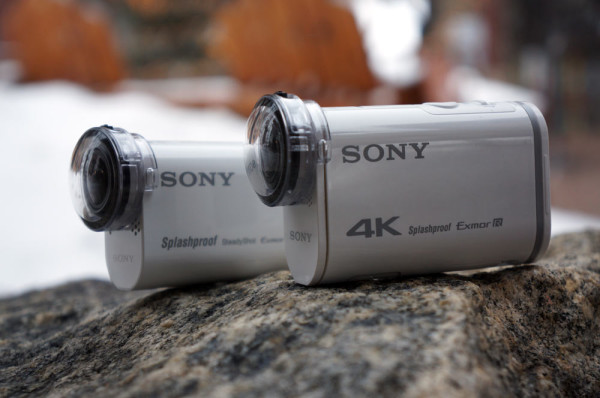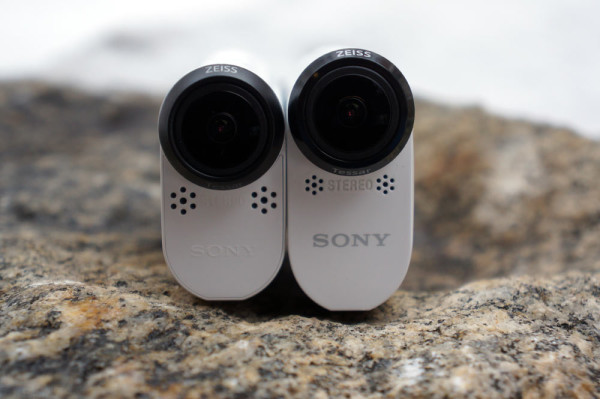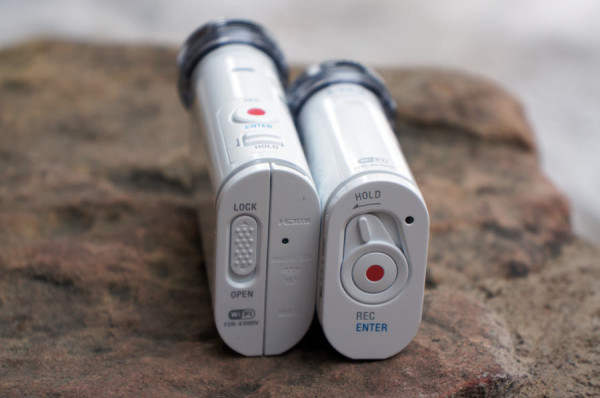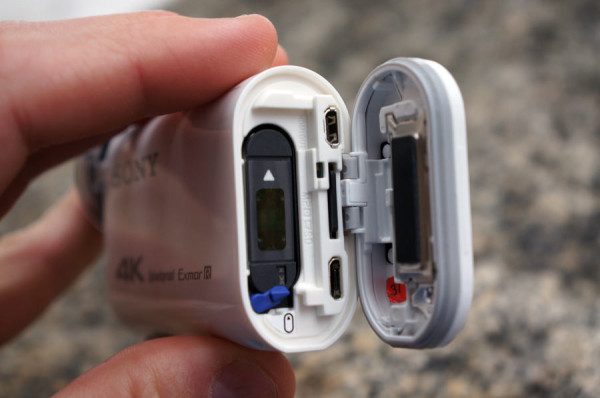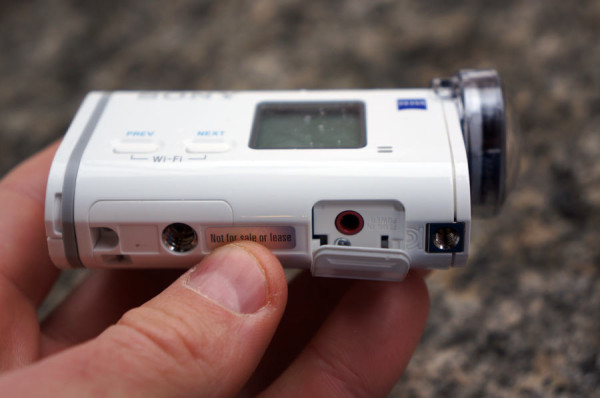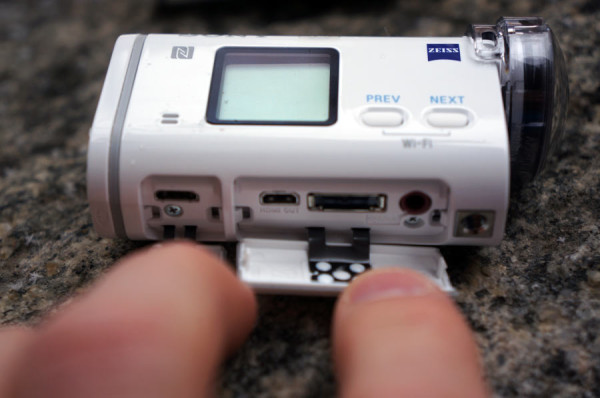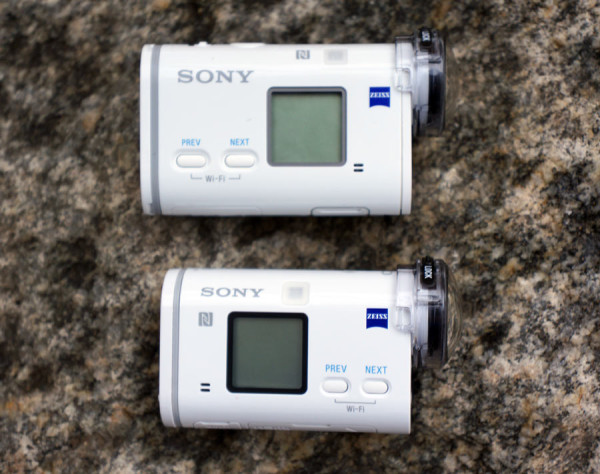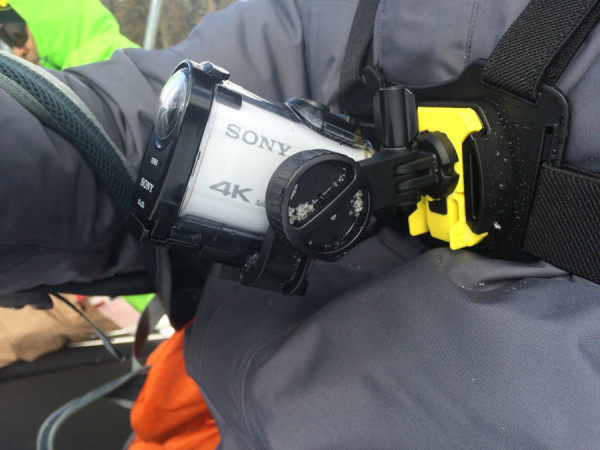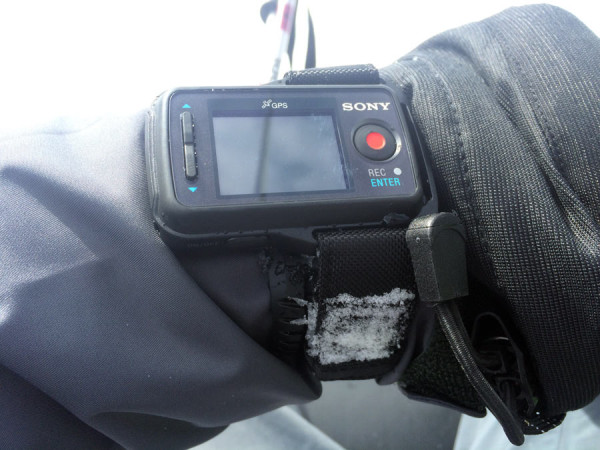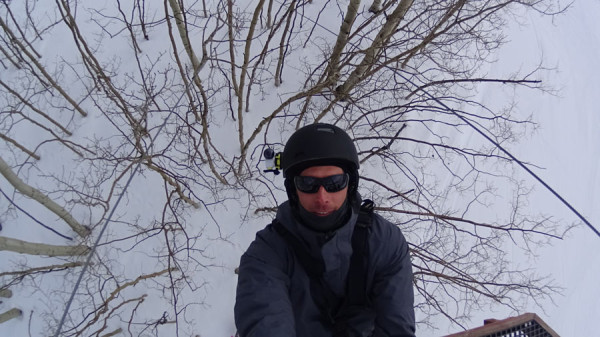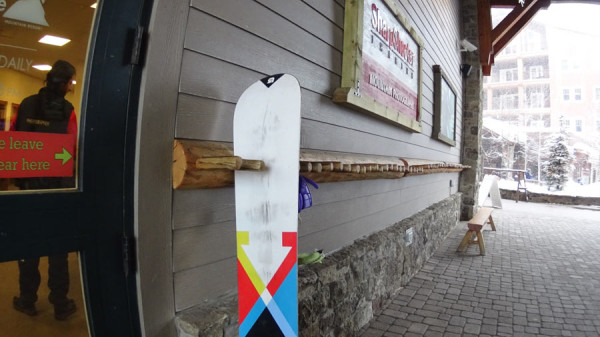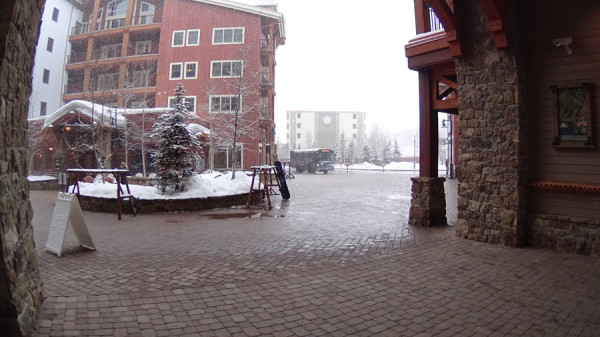After launching their new 4K Action Cam at CES earlier this year, Sony invited us out for a quick trip to get acquainted with it and the new second-in-command AS200V. The full tech specs and features of each are outlined in our launch coverage, this story focuses more on the user experience and includes video and photo examples from the cameras.
While 4K is just starting to make inroads, there’s little doubt it’ll dominate flat screen television sales by the time Friday’s turn black this November. But even if you have no plans on upgrading, there are some compelling reasons to consider the bigger 4K model over the quite capable 200 or even the super impressive Mini AZ1 Action Cam. Here’s what you need to know…
The 4K (technically known as the FDR-X1000V) is physically larger than the 200 and other models that preceded it. That means your existing waterproof housing won’t fit it, but all of the other accessories, mounts and batteries will. Well, not the Mini’s batteries, but any other full size Action Cam uses the same ones.
Besides the form factor, a major feature that separates Sony’s models from GoPro is the stereo microphones positioned right up front. They have a wind noise cancellation feature that can be turned on and off, and when it’s off there’s definitely some wind noise. I didn’t get a chance to test it with that off yet. Audio examples are in the videos below.
All the same buttons are there, too, just positioned differently. As are the ports…
The 4K model puts its USB and micro-HDMI ports behind the back cover with the battery and micro-SDHC card. User note: There’s not much room for graphics, so if you guess wrong on the memory card’s insertion and get an error message, just turn it off, flip it over and try again. That solved a bit of kicking and cursing for us. The battery has an arrow that mirrors the graphic above or below it, depending on model.
Underneath is the external microphone jack and 1/4-20 mounts.
The 200 puts all of its connectivity underneath.
VIDEO EXAMPLES
The video above was shot with the 4K model and comes with this disclaimer: What you’re seeing here is not in 4K because iMovie down-rezzes everything to 1080p, a fact I learned after importing everything and erasing the source material. This is important, and I’ll get to why further down. Remember to set the quality to it’s highest option. For now, a quick explanation of what you’re seeing:
- 0:00-0:16 – chest mount with w/p case
- 0:16-0:54 – selfie stick with w/p case at various angles
- 0:54-1:09 – forced (false) slow motion
- 1:10-1:28 – selfie stick held low with w/p case
- 1:28-1:50 – selfie stick fun, note color improvement on sunnier day
- 1:50-2:24 – Star Wars spaceship puppet to illustrate focus and cropping potential
- 2:24-2:50 – low light, actual (real) slow motion with wrist mount and no w/p case
The 4K Action Cam can record in 1080p @ 120fps, twice the frame rate of the AS200. That allows you to shoot high definition footage that’ll stay hi def even as you slow it down to 1/4 speed, allowing for some impressive slow motion trickery. That, and the ability to future proof the rest of your footage by capturing it in full 4K video, are the two main reasons to consider paying the extra $200. All of the other important tech features are identical to the AS200.
Now, about that slow motion. To take full advantage of it, you may need to learn to use a new bit of software. I’ve used iMovie for years and imported footage to there because that’s what I know. Much to my chagrin, it has a nasty habit of discarding extra frames and converting everything to 30fps. The first example of slow motion shows this with choppy slow motion despite originally recording at a higher frame rate. However, there is a setting in iMovie that will “automatically convert slow motion”, which it appeared to do for the last segment. The problem here is lack of control and Apple’s typical lack of any instructions on how to use their programs makes it difficult to predict results. So, best bet is to a) keep a copy of the raw video files as a backup elsewhere, and b) learn to use Sony’s Movie Creator software. It’s free, and it also allows you to overlay GPS info captured by the camera onto the video. In theory, anyway, we’re still working that one out, too. For those looking to do more professional editing, there’s Adobe Premier or Apple’s Final Cut Pro, neither of which are free but give you far more control.
The other reason 4K is beneficial is cropping. Technically, 4K is roughly four times the resolution of 1080p:
4K = 3840 x 2160 = 8,294,000 pixels
vs.
1080 = 1920 x 1080 = 2,073,600 pixels
So, if you’re shooting at 4K and will be outputting video at 1080, better video editors will be able to crop down the image while maintaining at least 1080p resolution. Given the wide recording angle of the Action Cam, as evidenced with the Star Wars fly by, it’s likely you may want to tighten up a few shots to keep the focus on the important things.
This video was shot with the AS200V. As fate would have it, my own AS100 ended up getting switched into Sony’s return pile and the AS200 came home with me. Upon searching desperately for the video I just knew I had recorded, the switcharoo dawned me. Since the press event was snow-only at Crested Butte, I made the most of the situation and took it out for a ride before boxing it up for return. The titles in this video explain it.
Because the Action Cam’s are splash proof, most of us ran the helmet mounted ones without the waterproof case…and the wind noise is rather evident at speed. But, the audio pickup when going slow is excellent, and conversations are picked up really well even when people are spread out.
The last bit of footage with the chest mount while riding shows the real value of Sony’s live-view wrist remote. Obviously, I didn’t use it here, and the footage is painfully downward angled. While the AZ1 mini cam comes with it out of necessity (it’s screen is too small to show all the functions on the camera body), it’s a $100 upgrade on the others.
It’s highly recommended for both the ability to see what you’re shooting ahead of time and also because you can easily switch modes and start/stop recording without having to reach for the camera. Even better, it can control multiple Action Cams at once and show you what each one sees in real time.
One last little video: This is just to show closeup filming with static products, giving you your first peek at our latest “World’s Funnest Bike” project! Note the curvature at the left and right edges, and how focus blurs out a bit when things get too close to the camera.
TECH TALK
I mentioned the tech specs in the original article about these camera’s coming out party, but anytime we get a chance to dive deep with the product folks, we do. That geeking out follows courtesy of many quick chats with Sony’s senior product manager for digital imaging, Yosuke Someya. As with all good action cameras, these will take still shots in timed repetition, on demand or in conjunction with shooting video. I’ve interspersed a few stills to break it up the text and illustrate what these cameras can do, none of which have any color correction or adjustments made to them.
First up, why Sony? Personally, I’ve owned many Sony Cameras and use them to shoot everything I do for Bikerumor outside of any competitive product testing. I think the color reproduction is excellent and the price-per-feature set is fair. Along those lines, Sony says their color reproduction for the Action Cam series may not be as exagerrated as competing models, but it’s more true to life and matches what’s captured by their other cameras and video cameras. So if you’re combining footage from multiple sources, it’ll have a consistent look.
Another reason? They make everything in house. Sony is, after all, a massive electronics company that makes all of their own camera equipment. Theoretically, that means better quality control over the finished product because they’ve managed it every step of the way.
The new SteadyShot is approximately 3x more effective than the prior models, particularly in dealing with high vibrations (think drones, RC helicopters). But, since it’s electronic image stabilization, it places a buffer around the edges of the image capture to allow it to “float” the recorded part around the image sensor as te camera bounces. The downside to is method is that it doesn’t work in 4K mode since 4K is using the full sensor. So, if you want image stabilization, record in 1080 or below.
Color perception is better now, too, because the new models process every pixel. Prior models and many other cameras claiming very high megapixel counts will use a process called “binning”, which groups pixels 2×2 during video capture, effectively using only half the pixels that are actually on the sensor. The 4K and AS200 capture light on every single pixel, so the result is more accurate color reproduction and fewer jagged edges.
With 4K, you have up to 100MB/s of data blasting from the image sensor through the circuitry to the memory card. Because of this, you need a special SDXC UHS-I card (U3) in order to capture video in 4K. And, to shoot more than 50MB/s, you’ll need to go into XAVC mode on the camera. XAVC-S is a newer format, built off MP4 and AVC HD and designed and led by Sony, but not exclusive to them.
Why a new video codec? Because higher bit rates of data capture allow for more detail. Someya says 100MB/s will capture more detail, good for fast moving action with more visual noise (think mountain biking through tree canopy), and 60MB/s is perfectly fine for slower motion activities or just filming scenery. A 64GB memory card will store about 1:15:00 of 4K recording…but the battery is good for only about 50 minutes, so get an extra. Speaking of batteries, I’ve found Sony’s batteries to last as advertised, assisted by the auto-shutoff feature on the Action Cams. In extreme cold, though, battery life can easily be cut in half.
If you’re not shooting in the highest quality settings, both cameras will also record in MP4 format, too. XAVC video can be imported into Sony’s Movie Creator software and converted to other formats, or you can just import directly into iMovie and have it convert (with the aforementioned caveats). If you’re working with full 4K video files, it may strain older computers.
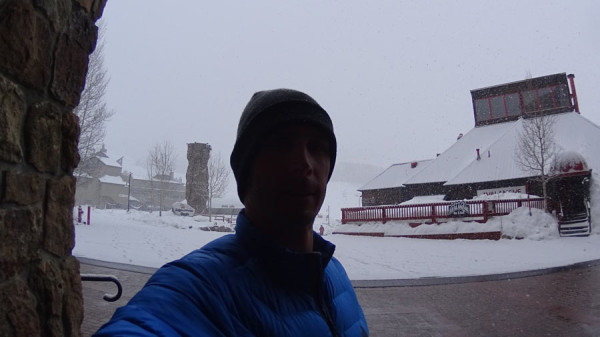

In addition to updated manual settings, Loop recording is a new feature that lets you capture video for a set amount of time on a loop without overwriting any previously recorded content. Different times can be set, or you can use “unlimited” to have it cycle through the entire memory card.
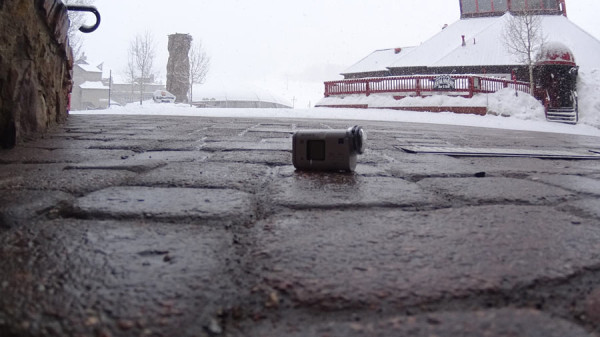
Another new features is the Highlight Movie Maker, which lets you quickly put together a short highlight reel, and the camera automatically flags what it thinks are highlights based on motion sensing, start and stops and scene detection. Then, using an iOS or Android app, it’ll wirelessly pull the highlight movie to your phone/tablet and let you quickly put put together an HD MPEG4 file with music and cut scenes. You can put videos together in any length you want in 15 second increments, making it perfect for quick sharing on Instagram or other social media. Check your app story for availability, the iOS version is not live as of this post. As with the Steady Shot, though, this won’t work with 4K footage because there’s simply too much data for the camera to process into a movie. So, if you wanna shoot something quick to send to your friends, go with 1080.
FIRST IMPRESSIONS
The less than stellar quality of my movies aside, these cameras are awesome. I like the color output, particularly in sunshine, and I love the wrist mounted live view remote. There’s no lag to the remote’s video, and it makes it much easier to control and use the camera. Since editing these movies, I’ve been researching better ways to use the footage, particularly with slow motion, so things will get better. It’s certainly not the camera’s fault, here. Now we just need to get the 4K in for long term review!
What’s important here is not my videography skills, but the feature set. These cameras bring tech specs as good or better than competing offerings, and as the Highlight Movie Maker and various apps come online, they’ll be able to do things no one else does. Just as Zach said with his review of the AZ1 mini, a camera’s only good if you’re able to use it, and Sony makes it extremely easy to use theirs. The Action Cams are certainly worth a look.
Check out the full Action Cam comparison chart on Sony’s website here.
